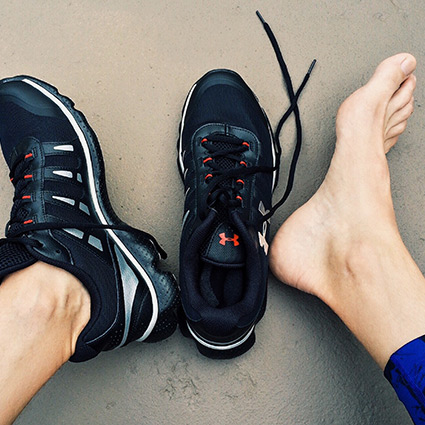 If you are experiencing pain in your foot and decided to research the topic online, odds are that you encountered some mention of this condition. Plantar fasciitis is a common condition resulting from inflammation of the plantar fascia, a band of tissue in the bottom of the foot, which supports the arch. The classic presentation of plantar fasciitis is a stabbing pain in the heel, particularly accompanying the first few steps taken in the morning[1]. Plantar fasciitis normally occurs as a result of repetitive strain, which leads to an inflamed condition. Things as simple and crucial to daily life as standing and walking, not to mention athletics and workplace activities, can contribute to the development of this problem.
If you are experiencing pain in your foot and decided to research the topic online, odds are that you encountered some mention of this condition. Plantar fasciitis is a common condition resulting from inflammation of the plantar fascia, a band of tissue in the bottom of the foot, which supports the arch. The classic presentation of plantar fasciitis is a stabbing pain in the heel, particularly accompanying the first few steps taken in the morning[1]. Plantar fasciitis normally occurs as a result of repetitive strain, which leads to an inflamed condition. Things as simple and crucial to daily life as standing and walking, not to mention athletics and workplace activities, can contribute to the development of this problem.
People most at risk for plantar fasciitis include:
- Runners and other athletes whose sport of choice involves running or jumping
- People aged 40-60
- People with flat feet or high arches
- People with unusual gaits that cause pronation (inner edges of feet lower than outer edges)
- Obese people
To be sure that you have plantar fasciitis and not a separate condition with similar presentation, be sure to consult with a person qualified to make medical diagnoses. Treatment may often involve time in physical therapy, where you will be shown home self-care techniques and exercises. Your physical therapist may also offer you corrective devices, such as orthotics or night splints, or show you how to properly tape your feet, to prevent improper movement. If your plantar fasciitis does not resolve or show signs of improvement within 6-12 months, your doctor may recommend cortisone injections. Usually, though, plantar fasciitis is treatable with proper self-care.
As an adjunct to stretches prescribed by a doctor or physical therapist, it is also important to reduce inflammation as much as possible. This can be accomplished by:
- Applying ice to the painful area, for a maximum of 18 minutes per hour
- Anti-inflammatory drugs prescribed or suggested by your doctor
- Turmeric supplementation [2]
- Proteolytic enzyme therapy [3]
- Rolling the foot with a foam roller [4]
- Topical anti-inflammatory products (e.g. arnica gel, CBD cream, Voltaren, Aspercreme)
Other approaches to assist you in combatting plantar fasciitis include:
- Losing weight if you are overweight – extra weight on the foot causes extra strain and may slow your recovery.
- Better shoes – the ideal shoe for a person with plantar fasciitis will be highly supportive of the arch.
- Change recreation – if you are willing and able, switch to forms of exercise which, even temporarily, put less stress on the feet. Examples of this would be swimming or cycling.
Another method for treating the fascia is the use of vibrational tools to break up fascial adhesion in the foot. Examples of vibrational tools available on the consumer market are the Theragun, the HoMedics Thumper, and the NordicTrack PulseTech Percussion Therapy Gun. These products can be used safely within tolerance to aid in the restoration of healthy fascial tone. In our office, Dr. Keeler uses more sophisticated vibrational tools as a regular part of treatment, and he has professional, medical knowledge of how to best apply them for maximum benefit.
Dealing with plantar fasciitis can be a struggle, and it can take a long time to resolve, but at Advanced Health Center Dr. Keeler and his staff are here to support you on your path to recovery.
Footnotes
